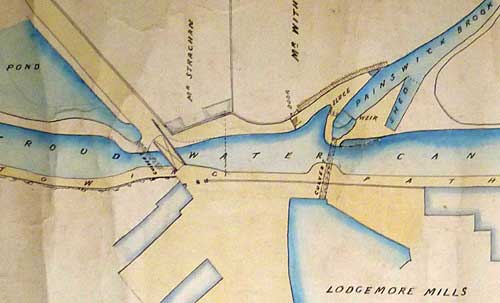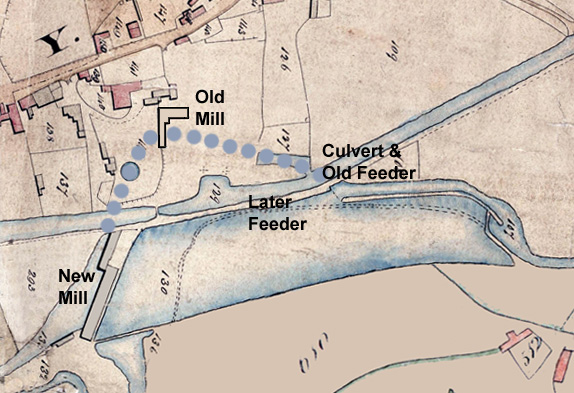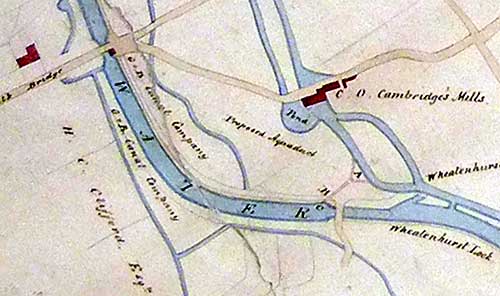The flow of water into and out of the canal was managed by a series of fixed and adjustable weirs, the principal feeds being from the Painswick stream at Lodgemore and from the River Frome at Ebley and Whitminster. Some water was also received when vessels passed to and from the Thames & Severn Canal. Under normal conditions, the water used while operating the canal locks during the week could be replenished on Sundays when the mills were not working. If there was a need for more water during the week, perhaps to refill a pound after being drained for maintenance, the Company's 1776 Act authorised taking it at any time, provided the mill owner was given 24 hours notice and was paid a stipulated recompense for each hour his mill was impeded, but this was only needed in exceptional circumstances.


The plan dated 1871 shows the Painswick stream coming down from the north-east on its way to the Lodgemore mill pond. Most of the flow passed under the canal through a culvert, but a sluice controlled by the Stroudwater Company could divert some of that water into the upper level of the canal when required. Another sluice could pass water from the stream through a pipe to a mill pond on the north side of the canal, and this fed another culvert under the canal.
The plan also shows a short arm off the Painswick stream labeled 'Shed', which is where sacks of grain brought up the canal by barge were loaded into small shallow-draught boats to be hauled up the stream to Stratford Mill.


The main source of water for the canal was a feed just upstream of Ebley Mill. Originally, there was an adjustable weir on the north side of the canal, being part of the structure of the culvert that carried the Frome under the canal on its way to the orginal mill on the north side of the canal. To suit the new mill built on the south side of the canal, the course of the river was changed in the 1820s, a large new mill pond was constructed and the old river was effectively filled in. Following concern about the structure of the culvert under the canal, a new adjustable feeder weir was built on the towpath side in 1850, and the remains of this can still be seen today. For more details, visit Ebley Feeder.


The plan dated 1831 shows the original weir above Whitminster Lock (near the right side) which could allow water to be drawn from the river to feed the canal when when there was much use of Framilode Lock. Following the opening of the Gloucester & Berkeley Canal, however, much more water was needed to compensate for the operation of the ship lock at Sharpness, and the Gloucester Company proposed to take it into the pound below Whitminster Lock though a new culvert labeled A and B. This proposal generated much concern about the effect it would have on the operation of Whitminster Mill and another mill downstream at Framilode. After much correspondence and some physical confrontations, the Gloucester Company bought both of the mills and eventally built the new feeder in 1835. When even more water was needed to suit operation of the larger lock at Sharpness new dock, the feeder was enlarged in 1877. That feeder is still supplying water to what is now called the Gloucester & Sharpness Canal.
Information about Water Management during the operational period up to 1941 can be found by searching the Minute Book and Letter Book pages in the Archives section of this website. Additionally, a list of relevant documents that can be consulted at Gloucestershire Archives can be found in the Subject Listings page under the heading Water Management.
Found in the Archive
The Stroudwater Company designated some employees as lock keepers who were responsible for ensuring water levels were always suitable for navigation, but in 1873 Thomas Lewis was severely criticised for leaving all of the gates of the shallow Whitminster Lock open so that the pound above was three inches below level.